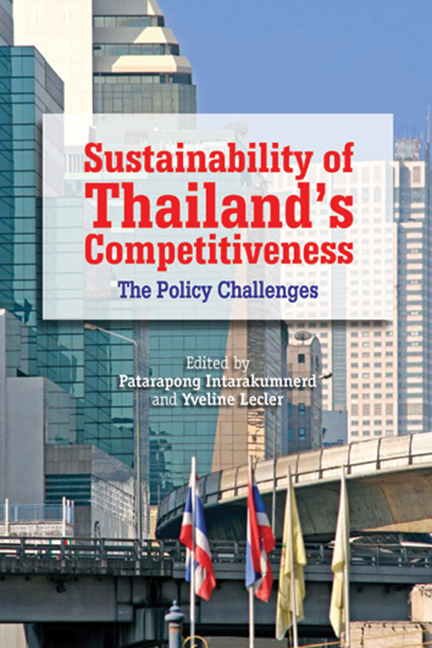Book contents
- Frontmatter
- Contents
- Preface
- Abbreviations
- Contributors
- Introduction
- Part I Thailand's Industrial Development: General Views
- Part II The Roles of Institutions: Clusters and Industrial Estates
- Part III Firms and Government New Initiatives: The Industry Analysis
- 6 Manufacturing and Management Systems of Japanese Manufacturers in Southeast Asia: The Case of Automobile Industry in Thailand
- 7 The Textile and Garment Industry in Thailand: The Technology and Education Upgrading Challenge
- 8 From Growth Based on Low Cost to Capability Upgrading Policies: The Thai Hard Disk Drive Industry
- Index
6 - Manufacturing and Management Systems of Japanese Manufacturers in Southeast Asia: The Case of Automobile Industry in Thailand
from Part III - Firms and Government New Initiatives: The Industry Analysis
Published online by Cambridge University Press: 21 October 2015
- Frontmatter
- Contents
- Preface
- Abbreviations
- Contributors
- Introduction
- Part I Thailand's Industrial Development: General Views
- Part II The Roles of Institutions: Clusters and Industrial Estates
- Part III Firms and Government New Initiatives: The Industry Analysis
- 6 Manufacturing and Management Systems of Japanese Manufacturers in Southeast Asia: The Case of Automobile Industry in Thailand
- 7 The Textile and Garment Industry in Thailand: The Technology and Education Upgrading Challenge
- 8 From Growth Based on Low Cost to Capability Upgrading Policies: The Thai Hard Disk Drive Industry
- Index
Summary
As earlier chapters have shown, the car industry is one of the major engines of growth of Thai industrial development in recent years. Its contribution to exports increased a lot after the Asian crisis of 1997, and the local content achieved is high in comparison with other high-tech industries such as electronics, for example. But, as the literature on this points out, this success is mainly due to the presence of MNCs; pure Thai firms involved in the industry are still quite few in number (Mori 2001; Lecler 2002). The importance of FDI in industrial development was also emphasized in previous chapters. In the car industry, the Japanese were the first and for a long time, the only ones, to invest in Southeast Asia as a whole, and also in Thailand. Unlike for electronics (see Chapter 8), American car makers came in much later.
This chapter will focus on the manufacturing and management strategies of Japanese car makers and their evolution over time, taking the electronics industry as a reference to illustrate specifications of past strategies, and those of American car makers to analyse more recent dynamics. But while speaking of Japanese car makers, we should also distinguish between them as they did not all follow the same strategy all the time. The history of Japanese car makers’ implementation in Southeast Asia and in Thailand is already well known, so it will just be briefly mentioned in each section to help position the shift in management strategies within the chronological evolution.
Japanese car makers started overseas operations around 1960, by which time the Japanese economy had managed to recover from the ruins of World War II. While they had not yet acquired a competitive advantage in global competition, they started overseas operations in Southeast Asia. Why did they start their oversea business by entering Southeast Asia? Although its market was too small to attract Western manufacturers, it was near Japan geographically, and there were no strong local competitors there.
- Type
- Chapter
- Information
- Sustainability of Thailand's CompetitivenessThe Policy Challenges, pp. 209 - 234Publisher: ISEAS–Yusof Ishak InstitutePrint publication year: 2010



